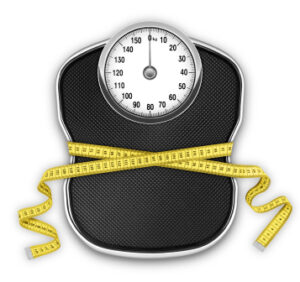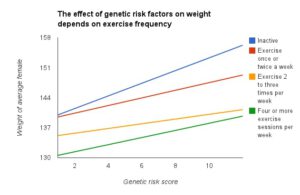By Nick Furlotte and Shirley Wu
For many of us, the battle of the bulge is more like an all-out war.
We all know people who can eat whatever they want, not work out, and yet not gain a pound. Meanwhile, eating just one burger, or missing just one cardio session, can weigh much more heavily on others (pun intended). No doubt many of the differences we observe in weight gain and its relation to food intake and exercise are due to genetics.
At 23andMe we are very interested in identifying the genetic components that contribute to these differences between individuals. So we assessed people’s food and exercise habits, their physical characteristics (like whether they are “apple” or “pear” shaped), and we compared these answers to genetic data for tens of thousands of customers with European ancestry.
How do fast food and exercise affect weight on average?*
In our customers, a man of average height (5’9), average age (35) and European ancestry weighs about 180 pounds (corresponding to a body mass index (BMI) of 26.5, lower than the
The story is similar for the average height and average aged woman (5’4 and 35 years old) with European ancestry, who weighs about 145 pounds (a BMI of 24.8, much lower than the U.S. average of 29). She will weigh about eight pounds less if she exercises once or twice a week, but will weigh three pounds more if she also eats fast food once or twice a week.
Why you should care if you’re apple or pear
None of this is surprising — exercise leads to lower weight on average while eating fast food leads to higher weight on average. But it turns out that body type makes a difference.
In our customers, men with pear and apple body types weighed more if they ate fast food occasionally while men with a neutral body type weighed less with the same fast food intake. For women, having an apple shape is associated with a higher average weight (around 155 pounds) but there is very little difference in weight due to occasional fast food intake between the different body types.
Just don’t go overboard: women who ate fast food nearly every day tended to weigh about 20 pounds more than the average, and this went up by an additional six pounds for women with apple or pear shapes.
More reason to exercise
We all burn calories while we’re just sitting around, but wouldn’t it be great if you could burn more? It all depends on your “metabolic rate”, or how much energy (calories) your body uses while resting, and you can actually increase your metabolic rate by exercising regularly.
In 23andMe customers, we see this play out in the fact that physical activity level affects the degree to which fast food consumption impacts weight. For example, an average man who eats fast food once or twice a week who also works out five to seven times a week weighs five pounds less than a man eating the same amount of fast food who does not work out at all. The story is similar for women: eating fast food and not exercising is associated with weighing 10 pounds more than average, while those who ate the same amount of fast food but also exercised frequently weighed only seven pounds more.
Of course, the difference in weight might not be due just to exercise frequency. People who exercise might also be doing other things that lead to lower weight, including eating a healthier diet overall. But the fact that exercise raises the metabolic rate makes it a plausible explanation.
Adding genetics to the picture
So how do our genetics influence all of this? We know that certain genetic factors predispose to obesity while others may protect against it. But a recent study published in PLOS Genetics adds a twist. The researchers showed that a set of 12 genetic factors known to be associated with obesity had less of an effect in people who exercised more and a larger effect in people who did not exercise as often.
We examined the same idea using the data from our customers and found similar results. In women who do not exercise, the genetic risk factors were associated with weighing 1.4 pounds more than average, while women who exercised weighed only 0.75 pounds more for each risk factor. In other words, lifestyle may actually influence the effect our DNA has on our weight.
As the size of the weight loss industry attests, weight and obesity are very challenging problems. But with more data, we’ll be able to unravel the relationship between food intake, exercise, genetics, and weight gain even more, hopefully leading to more personalized and effective healthy weight strategies.
* Analyses of average weight controlled for age, exercise frequency, fast food intake, and ancestry substructure.



